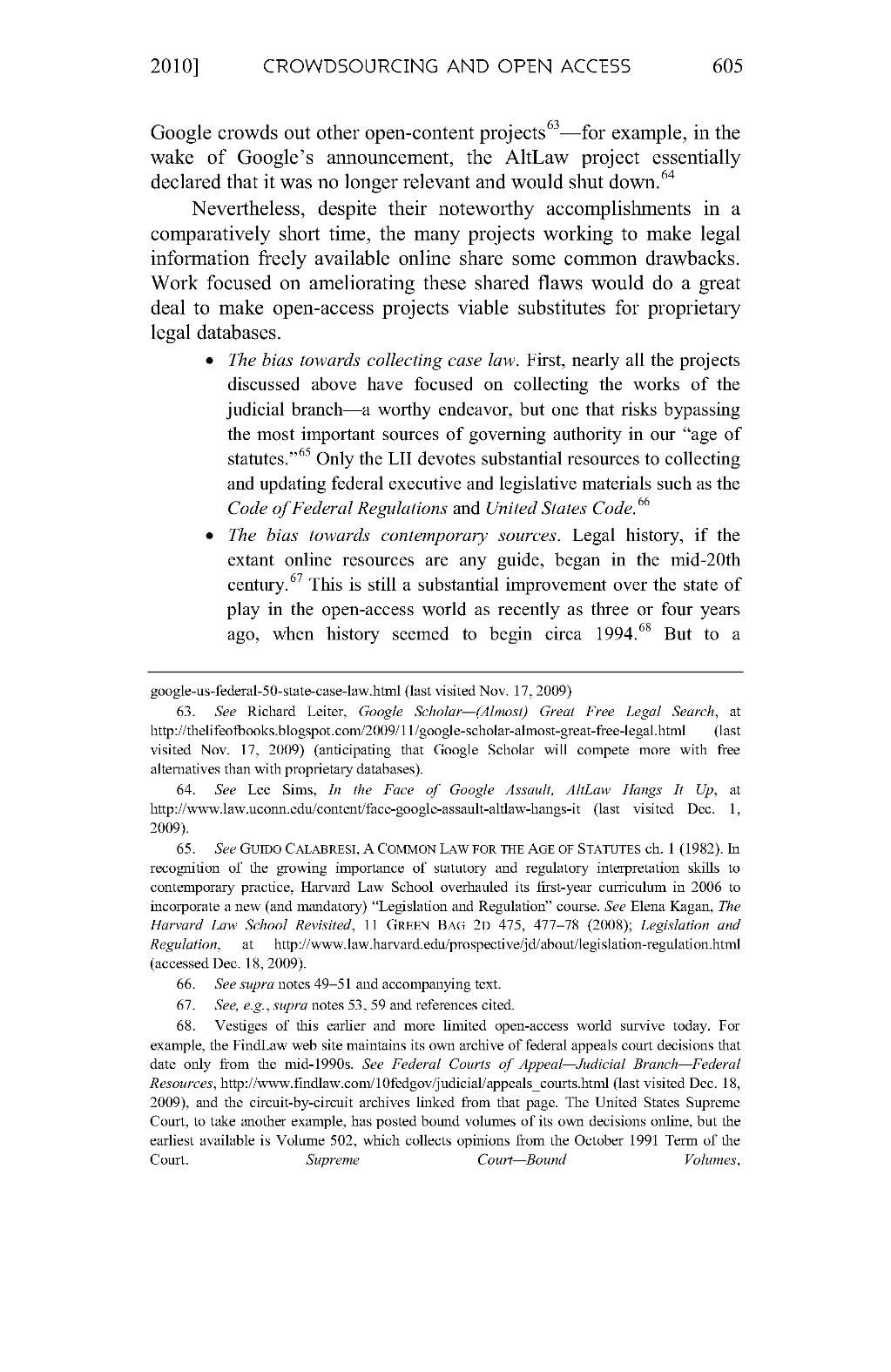This page has been validated.
2010]
CROWDSOURCING AND OPEN ACCESS
605
Google crowds out other open-content projects[1]—for example, in the wake of Google’s announcement, the AltLaw project essentially declared that it was no longer relevant and would shut down.[2] Nevertheless, despite their noteworthy accomplishments in a comparatively short time, the many projects working to make legal information freely available online share some common drawbacks. Work focused on ameliorating these shared flaws would do a great deal to make open-access projects viable substitutes for proprietary legal databases.
- The bias towards collecting case law. First, nearly all the projects discussed above have focused on collecting the works of the judicial branch—a worthy endeavor, but one that risks bypassing the most important sources of governing authority in our “age of statutes.”[3] Only the LII devotes substantial resources to collecting and updating federal executive and legislative materials such as the Code of Federal Regulations and United States Code.[4]
- The bias towards contemporary sources. Legal history, if the extant online resources are any guide, began in the mid-20th century.[5] This is still a substantial improvement over the state of play in the open-access world as recently as three or four years ago, when history seemed to begin circa 1994.[6] But to a
- ↑ See Richard Leiter, Google Scholar—(Almost) Great Free Legal Search, at http://thelifeofbooks.blogspot.com/2009/11/google-scholar-almost-great-free-legal.html (last visited Nov. 17, 2009) (anticipating that Google Scholar will compete more with free alternatives than with proprietary databases).
- ↑ See Lee Sims, In the Face of Google Assault, AltLaw Hangs It Up, at http://www.law.uconn.edu/content/face-google-assault-altlaw-hangs-it (last visited Dec. 1, 2009).
- ↑ See Guido Calabresi, A Common Law for the Age of Statutes ch. 1 (1982). In recognition of the growing importance of statutory and regulatory interpretation skills to contemporary practice, Harvard Law School overhauled its first-year curriculum in 2006 to incorporate a new (and mandatory) “Legislation and Regulation” course. See Elena Kagan, The Harvard Law School Revisited, 11 Green Bag 2d 475, 477–78 (2008); Legislation and Regulation, at http://www.law.harvard.edu/prospective/jd/about/legislation-regulation.html (accessed Dec. 18, 2009).
- ↑ See supra notes 49–51 and accompanying text.
- ↑ See, e.g., supra notes 53, 59 and references cited.
- ↑ Vestiges of this earlier and more limited open-access world survive today. For example, the FindLaw web site maintains its own archive of federal appeals court decisions that date only from the mid-1990s. See Federal Courts of Appeal—Judicial Branch—Federal Resources, http://www.findlaw.com/10fedgov/judicial/appeals_courts.html (last visited Dec. 18, 2009), and the circuit-by-circuit archives linked from that page. The United States Supreme Court, to take another example, has posted bound volumes of its own decisions online, but the earliest available is Volume 502, which collects opinions from the October 1991 Term of the Court. Supreme Court—Bound Volumes,
(last visited Nov. 17, 2009).
